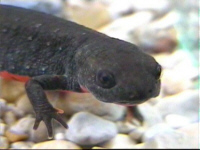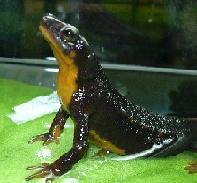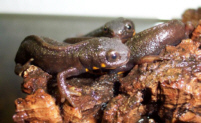Feuerbauchmolche
Feuersalamander
Kaukasussalamander
Kurzfußmolche
Grünl.
Wassermolch
Molch
Register
AG
Urodela
DGHT
The Newt-Registry of the genus Cynops
(AG Urodela / Work Group for Tailed Amphibians)
Newt-Register Keeping Literature Registration Cynopsseiten
| ensicauda | pyrrhogaster | cyanurus | |
| orphicus | wolterstorffi | chenggongensis | Verbreitungskarte |
Although the AG Urodela is associated with the DGHT (German Society for Herpetology and Reptile/Amphibian Husbandry) a lot of enthusiasts from all over the world and especially Europe are members and participate in the activities of this Work Group. Therefore, also the newt registry for the genus Cynops should be regarded as an international and especially Pan-European endeavour.
The newt-registry for Cynops aims at the following goals:
1. The conservation of rare and endangered species by captive breeding.
2. The coordinated exchange of animals, respectively their offspring between registry members (studbook) and thus the reduction of collection of animals in their natural habitats and imports.
3. The issue- and species-related counselling of beginners as well as advancers by the registry tutors.
4. Engrossing of knowledge on species biology through captive keeping and breeding.
5. Provision of captive bred animals for potential restoration projects.
6. The compilation of species-specific literature.
7. The compilation of a picture archive for this genus.
The genus Cynops comprises seven currently recognized species. The animals belonging to Cynops are small to medium sized newts, which spend significant periods of their life-cycle in the water.
Two species - C. pyrrhogaster and C. ensicauda - occur on the Japanese islands whereas five – C. orientalis, C. cyanurus, C. wolterstorffi, C. orphicus and C. chenggongensis – can be found on the Chinese mainland.
Newts of this genus are commonly known as „Firebellied Newts“ and have been popular among enthusiasts for decades. In the past, C. pyrrhogaster, the Japanese Firebellied Newt, used to be the only species that was imported in Europe and North America. Because of legal restrictions, this species has been replaced by the Chinese Dwarf- or Firebellied Newt - C. orientalis in recent years.
Currently there are two more Cynops species kept by European enthusiasts. C. ensicauda the Sword-Tailed Newt from the Southern Japanese Riu-Kiu archipelago and the Kweichow-Firebellied Newt - C. cyanurus, ocurring in the highlands of the Chinese province of Guizhou.
The situation within the genus Cynops in Europe differs significantly for particular species and thus different species-specific focal points are adressed in the registry work.
|
Cynops orientalis is the only species, which is still being imported in masses with the animals usually being in a terrible condition. There is sufficient captive breeding in Europe, which renders further imports of wildcaught animals unnecessary. First objective of the registry must therefore be the dissemination of information on these facts and to provide an alternative to imports by supplying captive bred offspring, which is usually longer-lived and healthier. Cynops orientalis, photo: Catrin Grollich |
|
|
The situation for the
two subspecies of Cynops
ensicauda is quite different. Whereas C.e. popei is bred regularly, only few reproductive groups of C.e.ensicauda
exist in Europe. The main goal for this subspecies must therefore be the
establishment of additional breeding groups. Since either of the
subspecies are no longer exported from Japan, captive breeding attains an
even greater importance nowadays.
Cynops
ensicauda ensicauda, photo: Tim Jonson |
|
Cynops cyanurus is bred occasionally in European aquariums. The two subspecies C.c. cyanurus and C.c. yunnanensis have been described. The differentiation of these subspecies still poses a problem and thus the groups in the registry cannot be assigned to either one. A problem still to be solved. Cynops
cyanurus, photo: Ralf Reinartz |
|
Cynops orphicus does not occur in private terrariums. |
|
Cynops chenggongensis most probably is and has not been kept in captivity anywhere. For these two rare species mentioned above, the establishment of stable breeding groups in captivity could help to avoid the risk of complete extinction caused by the depletion of natural habitats. |
|
Cynops wolterstorffi is presumably extinct already. An excursion to the natural habitat for the confirmation would be very much desirable. If remnant populations or animals could be ascertained, conservation measures like the establishment of nature reserves had to be put into effect. Experienced breeders could also engage in a breeding program for restoration purposes of this species.
|
|
Anybody
keeping one or more Cynops
species is invited to participate in the registry. The participants are informed about the status of the registry, appropriate literature, breeding success and everything else being of interest for the keepers of Cynops newts; the exchange of animals as well as information between participants is supported. Registry members have access to the registry’s bibliography as well as the picture archive, the latter being still under construction. Everybody is invited to make suggestions concerning the registry. Contact
the Cynops registry: Paul Bachhausen Am Püttkamp 20 40629 Düsseldorf e-mail: cynops [AT] gmx.de |
The following species/genera are also currently fostered by the AG Urodela and their own newt-registries:
Neurergus
crocatus, Neurergus kaiseri, Neurergus microspilotus, Tylototriton shanjing,
Tylototriton taliangensis, Triturus pygmaeus, Euproctus platycephalus, Ranodon
sibiricus, Hynobius dunni, Ambystoma macrodactylum, Pleurodeles poireti, Taricha,
Salamandra




